Paul Gilster's Blog, page 91
February 15, 2019
Breakthrough Propulsion Study
Ideas on interstellar propulsion are legion, from fusion drives to antimatter engines, beamed lightsails and deep space ramjets, not to mention Orion-class fusion-bomb devices. We’re starting to experiment with sails, though beaming energy to a space sail is still an unrealized, though near-term, project. But given the sheer range of concepts out there and the fact that almost all are at the earliest stages of research, how do we prioritize our work so as to move toward a true interstellar capability? Marc Millis, former head of NASA’s Breakthrough Propulsion Physics project and founder of the Tau Zero Foundation, has been delving into the question in new work for NASA. In the essay below, Marc describes a developing methodology for making decisions and allocating resources wisely.
by Marc G Millis

In February 2017, NASA awarded a grant to the Tau Zero Foundation to compare propulsion options for interstellar flight. To be clear, this is not about picking a mission and its technology – a common misconception – but rather about identifying which research paths might have the most leverage for increasing NASA’s ability to travel farther, faster, and with more capability.
The first report was completed in June 2018 and is now available on the NASA Technical Report Server, entitled “Breakthrough Propulsion Study: Assessing Interstellar Flight Challenges and Prospects.” (4MB file at: http://hdl.handle.net/2060/20180006480).
This report is about how to compare the diverse propulsion options in an equitable, revealing manner. Future plans include creating a database of the key aspects and issues of those options. Thereafter comparisons can be run to determine which of their research paths might be the most impactive and under what circumstances.
This study does not address technologies that are on the verge of fruition, like those being considered for a probe to reach 1000 AU with a 50 year flight time. Instead, this study is about the advancements needed to reach exoplanets, where the nearest is 270 times farther (Proxima Centauri b). These more ambitious concepts span different operating principles and levels of technological maturity, and their original mission assumptions are so different that equitable comparisons have been impossible.
Furthermore, all of these concepts require significant additional research before their performance predictions are ready for traditional trade studies. Right now their values are more akin to goals than specifications.
To make fair comparisons that are consistent with the varied and provisional information, the following tactics are used: (1) all propulsion concepts will be compared to the same mission profiles in addition to their original mission context; (2) the performance of the disparate propulsion methods will be quantified using common, fundamental measures; (3) the analysis methods will be consistent with fidelity of the data; and (4) the figures of merit by which concepts will be judged will finally be explicit.
Regarding the figures of merit – this was one of the least specified details of prior interstellar studies. It is easy to understand why there are so many differing opinions about which concept is “best” when there are no common criteria with which to measure goodness. The criteria now include quantifiable factors spanning: (1) the value of the mission, (2) the time to complete the mission, and (3) the cost of the mission.
The value of a mission includes subjective criteria and objective values. The intent is to allow the subjective factors to be variables so that the user can see how their interests affect which technologies appear more valuable. One of those subjective judgments is the importance of the destination. For example, some might think that Proxima Centauri b is less interesting than the ‘Oumuamua object. Another subjective factor is motive. The prior dominant – and often implicit – figure of merit was “who can get there first.” While that has merit, it can only happen once. The full suite of motives continue beyond that first event, including gathering science about the destinations, accelerating technological progress, and ultimately, ensuring the survival of humanity.
Examples of the objective factors include: (1) time within range of target; (2) closeness to target (better data fidelity); and (3) the amount of data acquired. A mission that gets closer to the destination, stays there longer, and sends back more data, is more valuable. Virtually all mission concepts have been limited to fly-by’s. Table 1 shows how long a probe would be within different ranges for different fly-by speeds. To shift attention toward improving capabilities, the added value (and difficulty) of slowing at the destination – and even entering orbit – will now be part of the comparisons.
Table 1: Time on target for different fly by speeds and instrumentation ranges

Quantifying the time to complete a mission involves more than just travel time. Now, instead of the completion point being when the probe arrives, it is defined as when its data arrive back at Earth. This shift is because the time needed to send the data back has a greater impact than often realized. For example, even though Breakthrough StarShot aims to get there the quickest, in just 22 years, that comes at the expense of making the spacecraft so small that it takes an additional 20 years to finish transmitting the data. Hence, the time from launch to data return is about a half century, comparable to other concepts (46 yrs = 22 trip + 4 signal + 20 to transmit data). The tradeoffs of using a larger payload with a faster data rate, but longer transit time, will be considered.
Regarding the total time to complete the mission, the beginning point is now. The analysis includes considerations for the remaining research and the subsequent work to design and build the mission hardware. Further, the mission hardware, now by definition, includes its infrastructure. While the 1000 AU precursor missions do not need new infrastructure, most everything beyond that will.
Recall that the laser lightsail concepts of Robert Forward required a 26 TW laser, firing through a 1,000 km diameter Fresnel lens placed beyond Saturn (around 10 AU), aimed at a 1,000 km diameter sail with a mass of 800 Tonnes. Project Daedalus envisioned needing 50,000 tonnes of helium 3 mined from the atmospheres of the gas giant planets. This not only requires the infrastructure for mining those propellants, but also processing and transporting that propellant to the assembly area of the spacecraft. Even the more modest Earth-based infrastructure of StarShot is beyond precedent. StarShot will require one million synchronized 100 kW lasers spread over an area of 1 km2 to get it up to the required 100 GW.
While predicting these durations in the absolute sense is dubious (predicting what year concept A might be ready), it is easier to make relative predictions (if concept A will be ready before B) by applying the same predictive models to all concepts. For example, the infrastructure rates are considered proportional to the mass and energy required for the mission – where a smaller and less energetic probe is assumed to be ready sooner than a larger, energy-intensive probe.
The most difficult duration to estimate, even when relaxed to relative instead of absolute comparisons, is the pace of research. Provisional comparative methods have been outlined, but this is an area needing further attention. The reason that this must be included – even if difficult – is because the timescales for interstellar flight are comparable to breakthrough advancements.
The fastest mission concepts (from launch to data return) are 5 decades, even for StarShot (not including research and infrastructure). Compare this to the 7 decades it took to advance from the rocket equation to having astronauts on the moon (1903-1969), or the 6 decades to go from the discovery of radioactivity to having a nuclear power plant tied to the grid (1890-1950).
So, do you pursue a lesser technology that can be ready sooner, a revolutionary technology that will take longer, or both? For example, what if technology A is estimated to need just 10 more years of research, but 25 years to build its infrastructure, while option B is estimated to take 25 more years of research, but will require no infrastructure. In that case, if all other factors are equal, option B is quicker.
To measure the cost of missions, a more fundamental currency than dollars is used – energy. Energy is the most fundamental commodity of all physical transactions, and one whose values are not affected by debatable economic models. Again, this is anchoring the comparisons in relative, rather than the more difficult, absolute terms. The energy cost includes the aforementioned infrastructure creation plus the energy required for propulsion.
Comparing the divergent propulsion methods requires converting their method-specific measures to common factors. Laser-sail performance is typically stated in terms of beam power, beam divergence, etc. Rocket performance in terms of thrust, specific impulse, etc. And warp drives in terms of stress-energy-tensors, bubble thickness, etc. All these type-specific terms can be converted to the more fundamental and common measures of energy, mass, and time.
To make these conversions, the propulsion options are divided into 4 analysis groups, where the distinction is if power is received from an external source or internally, and if their reaction mass is onboard or external. Further, as a measure of propulsion efficiency (or in NASA parlance, “bang for buck”) the ratio of the kinetic energy imparted to the payload, to the total energy consumed by the propulsion method, can be compared.
The other reason that energy is used as the anchoring measure is that it is a dominant factor with interstellar flight. Naively, the greatest challenge is thought to be speed. The gap between the achieved speeds of chemical rockets and the target goal of 10% lightspeed is a factor of 400. But, increasing speed by a factor of 400 requires a minimum of 160,000 times more energy. That minimum only covers the kinetic energy of the payload, not the added energy for propulsion and inefficiencies. Hence, energy is a bigger deal than speed.
For an example, consider the 1-gram StarShot spacecraft traveling at 20% lightspeed. Just its kinetic energy is approximately 2 TJ. When calculating the propulsive energy in terms of the laser power and beam duration, (100 GW for minutes) the required energy spans 18 to 66 TJ, for just a 1-gram probe. For comparison, the energy for a suite of 1,000 probes is roughly the same as 1-4 years of the total energy consumption of New York City (NYC @ 500 MW).
Delivering more energy faster requires more power. By launching only 1 gm at a time, StarShot keeps the power requirement at 100 GW. If they launched the full suite of 1000 grams at once, that would require 1000 times more power (100 TW). Power is relevant to another under-addressed issue – the challenge of getting rid of excess heat. Hypothetically, if that 100 GW system has a 50% efficiency, that leaves 50 GW of heat to radiate. On Earth, with atmosphere and convection, that’s relatively easy. If it were a space-based laser, however, that gets far more dicey. To run fair comparisons, it is desired that each concept uses the same performance assumptions for their radiators.
Knowing how to compare the options is one thing. The other need is knowing which problems to solve. In the general sense, the entire span of interstellar challenges have been distilled into this “top 10” list. It is too soon to rank these until after running some test cases:
Communication – Reasonable data rates with minimum power and mass.
Navigation – Aiming well from the start and acquiring the target upon arrival, with minimum power and mass. (The ratio of the distance traversed to a ½ AU closest approach is about a million).
Maneuvering upon reaching the destination (at least attitude control to aim the science instruments, if not the added benefit of braking).
Instrumentation – Measure what cannot be determined by astronomy, with minimum power and mass.
High density and long-term energy storage for powering the probe after decades in flight, with minimum mass.
Long duration and fully antonymous spacecraft operations (includes surviving the environment).
Propulsion that can achieve 400 times the speed of chemical rockets.
Energy production at least 160,000 times chemical rockets and the power capacity to enable that high-speed propulsion.
Highly efficient energy conversion to minimize waste heat from that much power.
Infrastructure creation in affordable, durable increments.
While those are the general challenges common to all interstellar missions, each propulsion option will have its own make-break issues and associated research goals. At this stage, none of the ideas are ready for mission trade studies. All require further research, but which of those research paths might be the most impactive, and under what circumstances? It is important to repeat that this study is not about picking “one solution” for a mission. Instead, it is a process for continually making the most impactive advances that will not only enable that first mission, but the continually improving missions after that.
Ad astra incrementis.






February 14, 2019
Planet Formation: How Ocean Worlds Happen
It’s hard to fathom when we look at a globe, but our planet Earth’s substantial covering of ocean is relatively modest. Alternative scenarios involving ‘water worlds’ include rocky planets whose silicate mantle is covered in a deep, global ocean, with no land in sight. Kilometer after kilometer of water covers a layer of ice on the ocean floor in these models, making it unlikely that the processes that sustain life here could develop — how likely is a carbon cycle in such a scenario, and without it, how do we stabilize climate and make an inhabitable world?
These are challenging issues as we build the catalog of exoplanets and try to figure out local conditions. But it’s also intriguing to ask what made Earth turn out as dry as it is. Tim Lichtenberg developed a theory while doing his thesis at the Eidgenössische Technische Hochschule in Zürich (he is now at Oxford), and now presents it in a paper in collaboration with colleagues at Bayreuth and Bern, as well as the University of Michigan. Lichtenberg thinks we should be looking hard at the radioactive element Aluminium-26 (26Al).
Go back far enough in the evolution of the Solar System and kilometer-sized planetesimals made of rock and ice moved in a circumstellar disk around the young Sun, eventually through the process of accretion growing into planetary embryos. In this era a supernova evidently occurred in the astronomical neighborhood, depositing 26Al and other elements into the mix. Using computer simulations of the formation of thousands of planets, the researchers argue that two distinct populations emerge, water worlds and drier worlds like Earth.
“The results of our simulations suggest that there are two qualitatively different types of planetary systems,” says Lichtenberg: “There are those similar to our Solar System, whose planets have little water. In contrast, there are those in which primarily ocean worlds are created because no massive star, and so no Al-26, was around when their host system formed. The presence of Al-26 during planetesimal formation can make an order-of-magnitude difference in planetary water budgets between these two species of planetary systems.”
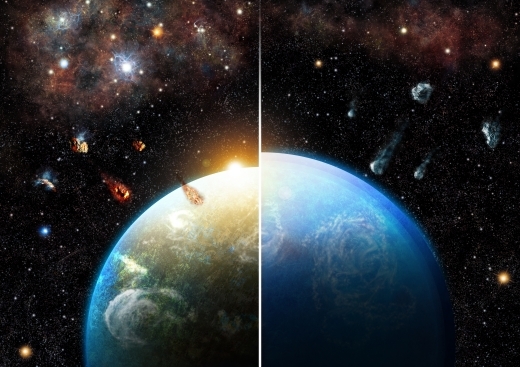
Image: Planetary systems born in dense and massive star-forming regions inherit substantial amounts of Aluminium-26, which dries out their building blocks before accretion (left). Planets formed in low-mass star-forming regions accrete many water-rich bodies and emerge as ocean worlds (right). Credit: Thibaut Roger.
Because planets grow from these early planetesimals, their composition is critical. If a great part of a planet’s water comes from them, then the danger of accreting too much water is always present if many of the constituent materials come from the icy regions beyond the snowline. But radioactive constituents like 26Al inside the planetesimals can create heat that can evaporate much of the initial water ice content before accretion occurs. Dense star-forming regions are more likely to produce planets that manifest these latter outcomes.
Lichtenberg and team examined the decay heat from 26Al in terms of this early planetesimal evolution, which would have led to silicate melting and degassing of primordial water abundances. Their simulations of planet populations delved into internal structures that varied according to disk structures, planetary composition, and initial location of planetary embryos. They produced statistical variations of incorporated water in planets that varied in radius and initial 26Al abundance. In all, the authors achieved what they believe to be a statistically representative set of 540,000 individual simulations over 18 parameter sets.

Image: This is Figure 3 from the paper. Caption: Fig. 3 | Qualitative sketch of the effects of 26Al enrichment on planetary accretion. Left, 26Al-poor planetary systems; right, 26Al-rich planetary systems. RP, planetary radius. Arrows indicate proceeding accretion (middle), planetesimal water content (bottom right, blue–brown) and live 26Al (bottom right, red–white). Credit: Lichtenberg et al.
We wind up with planetary systems with 26Al abundances similar to or higher than the Solar System forming terrestrial planets with lower amounts of water, an effect that grows more pronounced with distance from the host star, since embryos forming there are likely to be richer in water. Systems poor in 26Al are thus far more likely to produce water worlds. A remaining question involves the actual growth of rocky planets, as the paper notes:
If rocky planets grow primarily from the accumulation of planetesimals, then the suggested deviation between planetary systems should be clearly distinguishable among the rocky exoplanet census. If, however, the main growth of rocky planets proceeds from the accumulation of small particles, such as pebbles, then the deviation between 26Al-rich and 26Al-poor systems may become less clear, and the composition of the accreting pebbles needs to be taken into account.
The direction of future work to explore the question is clear;
… models of water delivery and planet growth need to synchronize the timing of earliest planetesimal formation, the mutual influence of collisions and 26Al dehydration, the potential growth by pebble accretion, and the partitioning of volatile species between the interior and atmosphere of growing protoplanets in order to further constrain the perspectives for rocky (exo-)planet evolution.
The paper is Lichtenberg et al., “A Water Budget Dichotomy of Rocky Protoplanets from 26Al-Heating,” Nature Astronomy Letters, 11 February 2019 (abstract). Thanks to John Walker for helpful information regarding this story.






February 13, 2019
Looking Back from System’s Edge
Sometimes the way we discover new things is by looking back, as witness the blue haze of Pluto. The image below comes, of course, from New Horizons, taken after the flyby and looking back in the direction of the Sun. Here we’re looking at a mosaic combining black and white LORRI images (Long Range Reconnaissance Imager) and enhancing them with lower-resolution color data from the Ralph/Multispectral Visible Imaging Camera (MVIC). The result, taken about 3.5 hours after closest approach, is in approximately true color.

Image: Pluto as seen by New Horizons from 200,000 kilometers after the flyby. The spectacular blue haze, extending to over 200 kilometers in altitude, is the result of sunlight acting on methane and other molecules in Pluto’s atmosphere to produce a photochemical haze. Credit: NASA/Johns Hopkins University Applied Physics Laboratory/Southwest Research Institute.
Ultima Thule likewise yields more of its secrets as we look at data from beyond the closest encounter. New Horizons’ latest target produced departure imagery fleshing out our view of the object’s shape by showing us parts of the KBO that were not illuminated by the Sun during the approach. We learn that the two lobes of Ultima Thule are not spherical at all, but rather that the larger lobe is flattened into a pancake shape, while the New Horizons team sees in the smaller lobe a resemblance to a dented walnut. Here is a video rendering of the data.
https://www.centauri-dreams.org/wp-content/uploads/2019/02/mu69_only_ca07_linear_0_to_50_extras.mp4
Image: Mission scientists created this “departure movie” from 14 different images taken by the New Horizons Long Range Reconnaissance Imager (LORRI) shortly after the spacecraft flew past the Kuiper Belt object nicknamed Ultima Thule (officially named 2014 MU69) on Jan. 1, 2019. The central frame of this sequence was taken on Jan. 1 at 05:42:42 UT (12:42 a.m. EST), when New Horizons was 8,862 kilometers (5,494 miles) beyond Ultima Thule, some 6.6 billion kilometers (4.1 billion miles) from Earth. The object’s illuminated crescent is blurred in the individual frames because a relatively long exposure time was used during this rapid scan to boost the camera’s signal level – but the science team combined and processed the images to remove the blurring and sharpen the thin crescent. This is the farthest movie of any object in our Solar System ever made by any spacecraft. Credit: NASA/Johns Hopkins Applied Physics Laboratory/Southwest Research Institute/National Optical Astronomy Observatory.
“We’ve never seen something like this orbiting the Sun,” says mission PI Alan Stern, adding:
“We had an impression of Ultima Thule based on the limited number of images returned in the days around the flyby, but seeing more data has significantly changed our view. It would be closer to reality to say Ultima Thule’s shape is flatter, like a pancake. But more importantly, the new images are creating scientific puzzles about how such an object could even be formed.”

Image: New Horizons took this image of Ultima Thule on Jan. 1, 2019, when the NASA spacecraft was 8,862 kilometers (5,494 miles) beyond it. The image to the left is an “average” of ten images taken by the Long Range Reconnaissance Imager (LORRI); the sharper processed view is to the right. Credit: NASA/Johns Hopkins Applied Physics Laboratory/Southwest Research Institute/National Optical Astronomy Observatory.
Observing stars as they disappeared when Ultima Thule passed in front of them allowed scientists to further refine the shape. The illustration below shows the evolution of our understanding, as we’ve moved from the ‘snowman’ to the ‘pancake’ model.
“While the very nature of a fast flyby in some ways limits how well we can determine the true shape of Ultima Thule, the new results clearly show that Ultima and Thule are much flatter than originally believed, and much flatter than expected,” adds Hal Weaver, New Horizons project scientist from the Johns Hopkins Applied Physics Laboratory. “This will undoubtedly motivate new theories of planetesimal formation in the early solar system.”
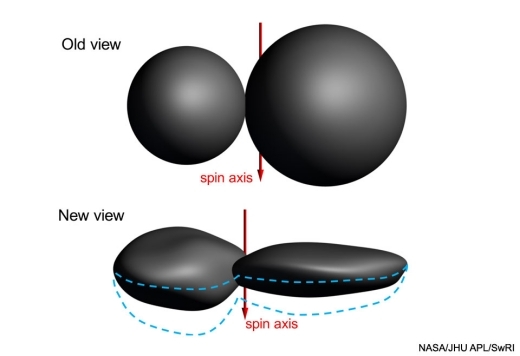
Image: Scientists’ understanding of Ultima Thule has changed as they review additional data. The “old view” in this illustration is based on images taken within a day of New Horizons’ closest approach to the Kuiper Belt object on Jan. 1, 2019, suggesting that both “Ultima” (the larger section, or lobe) and “Thule” (the smaller) were nearly perfect spheres just barely touching each other. But as more data were analyzed, including several highly evocative crescent images taken nearly 10 minutes after closest approach, a “new view” of the object’s shape emerged. Ultima more closely resembles a “pancake,” and Thule a “dented walnut.” The bottom view is the team’s current best shape model for Ultima Thule, but still carries some uncertainty as an entire region was essentially hidden from view, and not illuminated by the Sun, during the New Horizons flyby. The dashed blue lines span the uncertainty in that hemisphere, which shows that Ultima Thule could be either flatter than, or not as flat as, depicted in this figure. Credit: NASA/Johns Hopkins University Applied Physics Laboratory/Southwest Research Institute.






February 12, 2019
2019 Symposium Call for Papers

6th Interstellar Symposium and Interstellar Propulsion Workshop – TVIW 2019
In collaboration with the National Aeronautics and Space Administration (NASA), the Tennessee Valley Interstellar Workshop (TVIW) hereby invites participation in its 6th Interstellar Symposium and Interstellar Propulsion Workshop -hosted by Wichita State University (WSU) and Ad Astra Kansas Foundation – to be held from Sunday, November 10 through Friday, November 15, 2019, in Wichita, Kansas. The 2019 TVIW has the following elements:
The NASA Workshop on Interstellar Propulsion will focus solely on physics-based propulsion technologies that have the potential to meet the goal of launching an interstellar probe within the next century and achieving .1c transit velocity: Beamed Energy Propulsion, Fusion, and Antimatter.
At this meeting, the state-of-the-art of each will be examined, competing approaches to advancing the Technology Readiness Level (TRL) of each will be presented by advocates and assessed by non-advocates for synthesis into a workshop report to serve as the blueprint for possible future interstellar propulsion technology development.
The Interstellar Symposium will focus on all other aspects of interstellar travel excluding the advanced propulsion technologies to be covered in the NASA Workshop on Interstellar Propulsion, such as power, communications, system reliability/maintainability, psychology, crew health, anthropology, legal regimes and treaties, ethics, exoplanet science (possible destinations), and related research.
Working Tracks are collaborative, small group discussions around a set of interdisciplinary questions on an interstellar subject with the objective of producing “roadmaps” and/or publications to encourage further developments in the respective topics. This year we will be organizing the Working Tracks to follow selected plenary talks with focused discussions on the same topic.
Sagan Meetings. Carl Sagan famously employed this format for his 1971 conference at the Byurakan Observatory in old Soviet Armenia, which dealt with the Drake Equation. Each Sagan Meeting will invite five speakers to give a short presentation staking out a position on a particular question. These speakers will then form a panel to engage in a lively discussion with the audience on that topic.
Seminars are 3-hour presentations on a single subject, providing an in depth look at that subject. Seminars will be held on Sunday, November 10, 2019, with morning and afternoon sessions. The content must be acceptable to be counted as continuation education credit for those holding a Professional Engineer (PE) certificate.
Other Content includes, but is not limited to, posters, displays of art or models, demonstrations, panel discussions, interviews, or public outreach events.
Publications: Since TVIW serves as a critical incubator of ideas for the interstellar community, we intend to publish the work of TVIW 2019 in many outlets, including a complete workshop proceedings in book form.
No Paper, No Podium: If a written paper is not submitted by the final manuscript deadline, authors will not be permitted to present their work at the event. Papers should be original work that has not been previously published. Select papers may be submitted for professional publication, such as in the Journal of the British Interplanetary Society (JBIS).
Video and Archiving: All TVIW events may be captured on video or in still images for use on the TVIW website, in newsletters and social media. All presenters, speakers and selected participants will be asked to complete a Release Form that grants permission for TVIW to use this content as described.
ABSTRACT SUBMISSION
Abstracts for presented papers/presentations at TVIW 2019 may be submitted to either of two categories:
1. NASA Workshop on Interstellar Propulsion
2. Interstellar Symposium
Topics for Working Tracks, Sagan Meetings, Seminars, and Other Content are NOT solicited at this time.
Abstracts for the NASA Workshop on Interstellar Propulsion must relate to one of the three propulsion technologies of interest (Beamed Energy Propulsion, Fusion, and Antimatter) and should include the aspects of recent research, an assessment of the technology’s Technology Readiness Level (TRL) using NASA’s definitions found here, and a discussion of critical technical issues to be resolved with realistic, near-term technical development milestones identified (including relevant performance metrics).
Abstracts for the Interstellar Symposium must related to one or more of the many other interstellar mission related topics, such as power, communications, system reliability/maintainability, psychology, crew health, anthropology, legal regimes and treaties, ethics, exoplanet science (possible destinations), and propulsion technologies not explicitly called for in the NASA Workshop on Interstellar Propulsion.
Abstracts due: July 30, 2019.
All abstracts must be submitted online here.
PRESENTING AUTHOR(S) – Please list ONLY the author(s) who will actually be in attendance and presenting at the conference. (first name, last name, degree –for example, Susan Smith, MD)
ADDITIONAL AUTHORS – List all authors here, including Presenting Author(s) – (first name, last name, degree(s) – for example, Mary Rockford, RN; Susan Smith, MD; John Jones, PhD)
ABBREVIATIONS within the body should be kept to a minimum and must be defined upon first use in the abstract by placing the abbreviation in parenthesis after the represented full word or phrase. Proprietary drug names and logos may NOT be used. Non-proprietary (generic) names should be used.
ABSTRACT LENGTH – The entire abstract, (EXCLUDING title, authors, presenting author’s institutional affiliation(s), city, state, and text), including any tables or figures should be a maximum of 350 words. It is your responsibility to verify compliance with the length requirement.
Abstract Structure – abstracts must include the following headings:
Title – the presentation title
Background – describes the research or initiative context
Objective – describes the research or initiative objective
Methods – describes research methodology used. For initiatives, describes the target population, program or curricular content, and evaluation method
Results – summarizes findings in sufficient detail to support the conclusions
TRL Assessment and Justification (NASA Propulsion Workshop only)
Development Roadmap (NASA Propulsion Workshop only)
Near-term technical milestones and performance metrics (NASA Propulsion Workshop only)
Conclusions – states the conclusions drawn from results, including their applicability.
Questions and responses to this Call for Papers, Workshops and Participation should be directed to: info@tviw.us
For updates on the meeting, speakers, and logistics, please refer to the website: https://tviw.us/2019-symposium/
TVIW is incorporated in the State of Tennessee as a non-profit education organization. TVIW is a tax-exempt, 501(c)(3) educational, non-profit corporation by U.S. Internal Revenue Service. For U.S. tax purposes, all donations to TVIW are fully tax deductible (as allowed by your local laws).
Copyright © 2019 Tennessee Valley Interstellar Workshop, Inc. (TVIW), All rights reserved.






February 8, 2019
SETI’s Charismatic Megafauna
The search for technosignatures that could flag the presence of extraterrestrial cultures has accelerated in recent times with projects like Glimpsing Heat from Alien Technologies at Penn State and numerous papers. Or is the better term not ‘cultures’ but ‘societies,’ or ‘civilizations’? SETI’s funding challenges, at least from government agencies, point to the need for defining its terms in ways that NASA, for example, can live with. Nick Nielsen examines the question in today’s essay, probing the issue of terminology in relation to public support, and noting the ongoing effort to evaluate and revise how SETI is described. Nielsen, a frequent Centauri Dreams contributor and a member of the board of directors for Icarus Interstellar, is a prolific writer who tracks these and other space-related issues in Grand Strategy: The View from Oregon, and Grand Strategy Annex.
by J. N. Nielsen
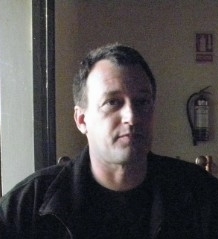
Recently there have been some signs that NASA may consider a rapprochement with SETI and SETI scientists, after more than twenty years of a de facto NASA ban on funding SETI (cf. NASA Renews Interest in SETI by David Grinspoon). It’s not yet clear how far this rapprochement will extend, but NASA did lend its name to the NASA Technosignatures Workshop (NTW18) last September. The event webpage names the Lunar and Planetary Institute, Universities Space Research Association, and National Aeronautics and Space Administration as having provided “institutional support”; I do not know if this involved financial support from NASA. The recent NASA Technosignatures Workshop also resulted in a 70 page paper, “NASA and the Search for Technosignatures: A Report from the NASA Technosignatures Workshop.”
I have to wonder if the term “technosignatures” is ultimately more palatable than the acronym “SETI,” with the latter’s explicit reference to ETI (extraterrestrial intelligence). “Technosignatures” sounds tech-savvy and doesn’t explicitly invoke aliens, though the idea of aliens is still there implicitly as a presupposition. This may sound like an overly-subtle gloss on the situation, but it is still a significant consideration. It is conceivable that NASA eventually will consider funding projects that mention “technosignatures” while continuing to pass over any project that mentions “SETI.”
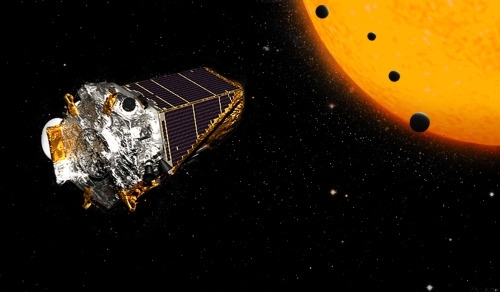
The need to re-brand SETI was discussed in by Calla Cofield, primarily discussing the recent work of SETI notable Jill Tarter. The author attributes to Tarter the idea that the acronym “SETI,” and what it has come to signify, “…generates an incorrect perception of what scientists in this field are actually doing.” Tarter also discusses the need for terminology reform. The question of SETI terminology has come in for a lot of discussion lately. We have seen the explicit consideration of SETI terminology in Wright’s paper “Taxonomy and Jargon in SETI as an Interdisciplinary Field of Study” and in the collective effort “Recommendations from the Ad Hoc Committee on SETI Nomenclature” by Jason T. Wright, Sofia Sheikh, Iván Almár, Kathryn Denning, Steven Dick, and Jill Tarter.
I found myself rather annoyed by the second of the two papers named in the paragraph above (I will henceforth call it the “Recommendations paper”), because it failed to deal with the hard conceptual problems presented by the terminology commonly used, and the hardest problems are usually the most interesting problems once you buckle down and focus on them with a will to really understand what is going on. Usually one finds that vague and imprecise terms paper over a multitude of subtle meanings, easily conflated, and it is a lot of work—sometimes tedious work—to separate out all these threads and give a full accounting of the ideas that are the background of the natural language employed in a science before that science is fully formalized.
Early analytical philosophers had a word for this clarification that has sadly fallen out of use: explication; take a look at Chapter 1 of Carnap’s Logical Foundations of Probability, “On Explication,” for a detailed exposition of explication. Carnap’s conception of explication could provide a framework for thinking about the explication of concepts employed in SETI. It was disappointing to me that the Recommendations paper is a laundry list of terms to use and terms to avoid, but, in fairness to the authors, the remit of the ad hoc committee was, “…to recommend standardized definitions for terms,” and not a root-and-branch re-thinking of the conceptual foundations of the discipline (which is what I would have liked to have seen).
Of particular interest to me in the Recommendations paper was its treatment of “civilization”:
Civilization
In a SETI context, e.g. (extraterrestrial or alien civilization) usually synonymous with technological species. Use with care.
Notes: The term civilization has imprecise popular meanings, but also particular scholarly meanings in relation to human history that are not generally what is meant by the term in a SETI context. Because of its ambiguity and anthropocentrism, the term is a suboptimal synonym for technological species, but it is nonetheless widely used in the literature. Society is a good alternative but not yet in common use.
It could be pointed out that “society” also has both imprecise popular meanings and particular scholarly meanings, so it is difficult to say how “society” is any better in this respect than “civilization.” I also question the idea that “technological species” is in any sense more precise or any less ambiguous than “civilization.”
The authors of the paper note that the use of “civilization” in SETI differs from its use in other scholarly contexts, but they don’t seem to be at all interested in why this is the case, or in finding some conception of civilization that is non-anthropocentric and is equally suitable for use in SETI and other sciences. This would be like someone saying that “BTU” is used to indicate energy in heating and “watt” is used to indicate energy in electricity, but that there is no need for any common conception of energy that might be an umbrella conception for BTU and watt (or calorie, or joule, etc.).
The same paper takes on the use of the term “advanced,” and while I agree that the term “advanced” is problematic, it is not problematic for the reasons cited in the paper. “Advanced” in isolation means nothing; it is a relational term. What would make sense is a formulation such as “x is more advanced than y.” With a little refinement we get, “x is a more advanced F than y.” Now, this latter formulation could be said to be in the same spirit as the recommendation in the paper of, “…simply specifying the scale or nature of the technology referenced.” I’m on board with this, as long as it is made clear that “advanced” is a relational term that is meaningless in isolation. What we find in most cases of using “advanced” in isolation is that the comparison is implicit; one of the virtues of formalizing any usage in a schema such as, “x is a more advanced F than y,” is that it forces us to make our assumptions explicit.
Clearly, however, the authors of the Recommendations paper mean to condemn, “…deprecated theories of human history which rank human societies from ‘primitive’ to ‘advanced’ based on ill-defined and ethnocentric measures.” No doubt the authors have the most virtuous motives for condemning what they see as ethnocentric measures to distinguish primitive from advanced civilizations, but—Alas!—science is unconcerned with the virtue of its practitioners, or the lack thereof. We could go a long way toward improving the situation by offering a precisely defined scale by which civilizations could be rank-ordered, but I doubt that this would quell the misgivings of those whose concern is addressing the grievances claimed to follow from ethnocentric bias. I will say no more at present regarding this.
In addition to his advocacy for SETI terminology reform, Jason Wright has also argued strongly that SETI is and ought to be a part of astrobiology (cf. “SETI is Part of Astrobiology”). Wright counters the official NASA line that, “Traditional SETI is not part of astrobiology,” by arguing that some of the most obvious signs of terrestrial habitability are Earth’s technosignatures. Wright also points out that NASA arbitrarily excludes technosignatures from “traditional SETI.” Obviously, to the extent that NASA’s exclusion is arbitrary, it is dissatisfying. Given that NASA has been deeply involved with astrobiology since its inception (cf. The Living Universe: NASA and the Development of Astrobiology by Steven J. Dick and James E. Strick, which discusses NASA’s involvement in astrobiology since the term was introduced), if SETI is part of astrobiology, and NASA was present at the foundations of astrobiology, then the case could be made that NASA’s astrobiology program should include SETI as an integral component, organically present ab initio. That is to say, SETI is not some foreign body that has become inexplicably lodged in astrobiology.
However, in a Twitter post, Jason Wright referenced two posts by Dr. Linda Billings, SETI: on the edge of astrobiology and Astrobiology and SETI: different evolutionary pathways, which argue against including SETI under the umbrella of astrobiology. These posts conclude, respectively, “The bottom line is that traditional SETI—using ground-based radio telescopes to listen for signals of extraterrestrial intelligent origin—falls outside the boundaries of NASA’s astrobiology program.” And, “…the history/evolution of exo/astrobiology more closely parallels the history/evolution of planetary protection. Exo/astrobiology and SETI evolved on very different, non-parallel tracks.” Thus the argument whether SETI ought to be considered a part of astrobiology has been made both in the affirmative and in the negative. It seems pretty weak to me to argue that SETI is intrinsically about ground-based observations, as SETI observations from space-based telescopes would be a great boost for the discipline, if only these resources were made available to SETI research. Wright deals with this weakness as one of the erroneous perceptions he identifies that has led to the exclusion of SETI from NASA’s astrobiology portfolio.
Much of this discussion is taking place because SETI is poorly funded, and if government monies were made available to SETI researchers, the discipline could pursue a more ambitious scientific research program. But because SETI has been largely frozen out of government funding through NASA, which would be its natural home (unless, like Billings, we see the National Science Foundation funded ground-based telescopes as the natural home of SETI), SETI funding efforts have taken creative forms. One of these creative ways of doing SETI science on the cheap has been projects that can be described as “parasitic,” “piggyback,” and “opportunistic.” This was taken up explicitly by Jill Tarter in 1984 in “Parasitic, Piggyback and Opportunistic SETI: It’s Cheap and It Just Might Work?”
A year prior, in 1983, the idea was already floated in “The Berkeley parasitic SETI program” by S. Bowyer, G. Zeitlin, J. Tarter, M. Lampton, and W. J. Welch. And since then we have seen, “The SERENDIP piggyback SETI project” by M. Lampton, S. Bowyer, D. Werthimer, C. Donnelly, and W. Herrick (1992) and “An Opportunistic Search for ExtraTerrestrial Intelligence (SETI) with the Murchison Widefield Array” by S. J. Tingay, C. Tremblay, A. Walsh, and R. Urquhart (2016). The latter paper characterizes their “opportunistic” SETI as follows:
“In this Letter, we present a first, and opportunistic, SETI pilot experiment with the MWA, in the frequency range 103–133 MHz, placing limits on narrow band radio emission toward 38 known planetary systems. The experiment is opportunistic in the sense that the observations were undertaken for a spectral line survey of the Galactic Plane that is ongoing; utility of the data for a SETI experiment was realised post-observation.”
There is a kind of subtle irony in SETI science having to operate parasitically on other projects deemed more fundable, or, at least, projects that would not draw the ire of politicians looking for a soft budgetary target to attack. Arguably, whatever public support that there is for space exploration (and however correct or mistaken it may be to connect space exploration with SETI), derives from the hope, perhaps even the titillating hope, of finding something “out there” that would mean that we are not alone.
I have often said that any excitement over things like exoplanet searches always turns on whether the planets are habitable, any excitement over whether the planet is habitable largely turns on whether we can ever determine whether or not these planets actually have life, any excitement over whether or not we can determine if these planets have life largely turns on whether that life could be intelligent, and any excitement over whether or not this life could be intelligent largely turns on whether we might possibly communicate with or travel to these intelligent beings. Space science, then, is to a large extent an artifact of our cosmic loneliness, and our desire to mitigate that cosmic loneliness.
I’ve read a few candid comments to this effect (I can’t remember the source), and I have no doubt that this is the case. In the same way that conservation biology has an easier time raising money to fight for charismatic megafauna, but has a much more difficult time raising money based on conservation efforts for unattractive animals or very small animals, so too space science efforts do better when they are related to some “sexy” space science topic like aliens — but this has to be done sotto voce, with a wink and a nudge, because NASA, to be taken seriously, must keep up the appearance of high seriousness. NASA’s budgetary choices are held hostage by the “giggle factor.”
In a sense, then, it is space science that is parasitic upon SETI and human spaceflight (which appeals as a source of national pride in accomplishment), which, when the latter dominated NASA and NASA’s budget, took the lion’s share of the money and left little for space science. In recent decades, the focus has been more on space science, and so it is SETI (rather than prestige) which is the unspoken background to what is going on explicitly in the foreground. While I care deeply about space science, and I know how much NASA’s space science programs have transformed our knowledge of the universe, few in the wider public share my sentiments, and they cannot be expected to so share these sentiments. But they can share an interest in the “charismatic megafauna” of astrobiology, which are the intelligent aliens that SETI is seeking.
If NASA can embrace technosignatures as a part of astrobiology, it may find a way to excite the interest of the public while maintaining its scientific respectability. And if that requires a shift in terminology, I suspect that SETI researchers will be ready to make that shift. An article by Lisa Grossman, It’s time to start taking the search for E.T. seriously, astronomers say: Some scientists are pushing for NASA to make looking for alien technology an official goal, notes that Jason Wright is part of a group of scientists who are actively seeking to have the search for technosignatures incorporated into NASA’s next Decadal Survey, which, if successful, would mean federal funding for SETI projects. Everyone is well aware that such funding would transform the discipline, and SETI advocates are now actively campaigning for the funding.
We can already see this transition to the language of technosignatures taking place. For example, if we take as a recent example the paper, “A search for technosignatures from TRAPPIST-1, LHS 1140, and 10 planetary systems in the Kepler field with the Green Bank Telescope at 1.15-1.73 GHz” by Pavlo Pinchuk, et al., we find that “technosignatures” are mentioned repeatedly throughout the text, “extraterrestrial” is mentioned ten times, “SETI” is mentioned a couple of times (as well as in the bibliography, in an internet address, and in a title), “civilization” is mentioned once, and “alien” appears nowhere in the document.
Any scientific discipline, as it evolves, eventually revises its terminology, as it usually begins with imprecise terms taken from ordinary language and eventually settles upon more formalized usages that are defined with scientific precision, and which become the accepted jargon of the discipline. There is scientific precision in spades to be found in SETI research papers. What is wanting in SETI (and in discussions of technosignatures, for that matter) is the conceptual framework within which these terms are formulated. SETI science is strong, but its concepts are often weak and ambiguous, as is evidenced by the recent concern with terminology. I have had this conceptual weakness on my mind for some time, and I hope to be able to write more about this as I clarify my own thoughts on the matter. Others seem to have noted this weakness as well. In a paper that has just come out by Jim Pass of the Astrosociology Research Institute, Exo-Astrosociology and the Search for Technosignatures, Pass notes:
“Unlike with the regard to discoveries associated with the search for biosignatures mostly in our Solar System, which have produced discoveries and insights of tangible value, the research associated with the search for technosignatures is less impressive.”
The charismatic megafauna of SETI—little green men, space aliens, Martians, and their kin—are emblematic of this conceptual weakness, and they could be made more respectable with a prolonged inquiry into and clarification of the conceptual framework within which we discuss the possibility of the emergent complexities we know on Earth—life, sentience, consciousness, intelligence, mind, technology, and civilization, inter alia — also existing elsewhere. If we have gotten the sequence of emergent complexities right, this sequence begins with biology, and so is initially an astrobiological inquiry. However, at some point it becomes an inquiry larger than astrobiology (or, if you prefer, an inquiry no longer narrowly contained within the boundaries of biological thought), and our conceptual framework must expand in order to accommodate this larger domain of inquiry. Explication, then, could play a crucial role in exorcising space aliens and replacing them with a theoretical construction more consonant with NASA’s demand for high seriousness.






February 7, 2019
Perspectives Beyond the Moon
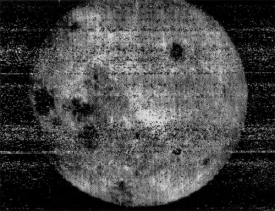
Today we re-enter the realm of perspective-altering photographs, images that open new vistas in our early reconnaissance of the Solar System. Before October 7, 1959, we had little knowledge of the far side of the Moon, even though librations allowed the occasional glimpse at extremely low angles of a small part of it. The Soviet moon probe Luna 3 took the first photographs of the far side, and was followed by the much better imagery of Zond 3 in 1965. NASA’s Lunar Orbiter program would continue the mapping as the 1960s progressed.
Image: First glimpse. The view of the Moon’s far side from Luna 3.
The far side would swim into vivid focus, of course, when Apollo 8 and subsequent missions took astronauts to the Moon, but it was up to the China National Space Administration to make the first soft landing there on January 3 of this year (Ranger 4 had impacted on the far side in 1962, but without returning data before impact). Working in this environment demanded a relay satellite to support communications with the Chang’e 4 mission on the surface.
The Queqiao satellite handles signals from the surface and relays them to Earth, working with a satellite called Longjiang-2, from which the image below was downloaded on February 3. Remember, for most of human history, we had no idea what the far side of the Moon looked like. Now we’ve not only mapped it, but can see a view of Earth with the entire far side laid out before us.
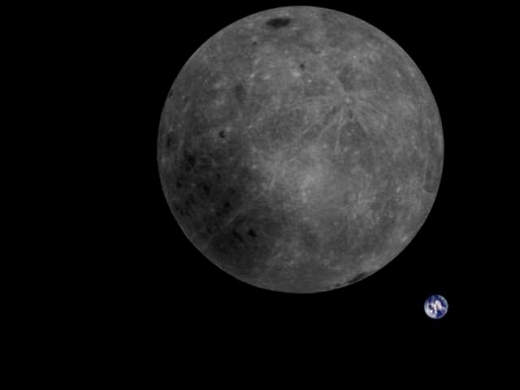
Image: Downloaded at the Dwingeloo Radio Observatory in the Netherlands, this view from Longjiang-2 shows the Earth and the Moon’s far side. The contrast in color is reminiscent of Bill Anders’ famous shot from Apollo 8, though here we see the Moon in its entirety.
Another perspective changer is the fact that Longjiang-2 is equipped with an amateur radio transceiver that allows radio amateurs to downlink telemetry and relay messages through it, as well as commanding it to take and downlink images, as explained in this page at the Dwingeloo website. What an opportunity for space-minded amateurs. They can work Longjiang-2 (call sign BJ1SN) and join the amateur team at Dwingeloo itself (PI9CAM) to see images that, not all that long ago, would have seemed astonishing. For many of us, ‘astonishing’ still applies.
I can’t leave the far side without comparing the above to the animation below, a spectacular shot of of the Earth and Moon as seen by the DSCOVR satellite (Deep Space Climate Observatory).
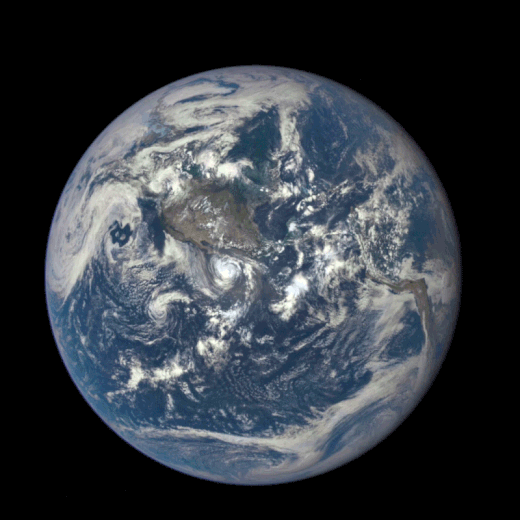
Image: This animation features satellite images of the far side of the Moon, illuminated by the Sun, as it crosses between the DSCOVR spacecraft’s Earth Polychromatic Imaging Camera (EPIC) and telescope, and the Earth — 1.6 million km (1 million miles) away. The times of the images span from 3:50 p.m. to 8:45 p.m. EDT on July 16, 2015. The time of the New Moon was at 9:26 p.m. EDT on July 15. Credit: NASA/NOAA.
Another perspective enhancer is the view below from MARCO-B, nicknamed WALL-E. Along with MARCO-A (also known as EVE), the CubeSat made it to Mars in a seven-month journey that provided data on the InSight landing on November 26, 2018. The data were valuable because Mars orbiters could not observe the entire landing sequence and route information swiftly back to Earth. The MARCOs returned data at each stage of the InSight descent and landing in near-real time, also beaming back InSight’s first image.
And despite the failure of MARCO-A’s camera, MARCO-B succeeded in fine fashion with the memorable animation below.

Image: MARCO-B, one of the experimental Mars Cube One (MARCO) CubeSats, took the images shown in the animation above as it approached Mars from about 575,000 kilometers (357,300 miles) to 18,000 kilometers (11,200 miles) away, just before NASA’s InSight spacecraft landed on Mars on Nov. 26, 2018. MARCO-B flew by Mars with its twin, MARCO-A, to serve as communications relays for InSight as it touched down on the Red Planet. Nicknamed WALL-E, MARCO-B took these images on Sunday, Nov. 25 and Monday, Nov. 26, 2018. The bright point of light to the left is the corner of MARCO-B’s high gain antenna feed and to the right is the high gain antenna, which let the CubeSat communicate with Earth. In this animation, Mars is spinning on its axis from right to left. Credit: NASA/JPL-Caltech.
There have been no further transmissions from MARCO-B since the end of December, while we last heard from MARCO-A in early January. We have this from JPL:
The mission team has several theories for why they haven’t been able to contact the pair. WALL-E has a leaky thruster. Attitude-control issues could be causing them to wobble and lose the ability to send and receive commands. The brightness sensors that allow the CubeSats to stay pointed at the Sun and recharge their batteries could be another factor. The MarCOs are in orbit around the Sun and will only get farther away as February wears on. The farther they are, the more precisely they need to point their antennas to communicate with Earth.
This summer the two diminutive spacecraft will begin moving back toward the Sun. MARCO-A is, based on calculations of its trajectory, now more than 3.2 million kilometers beyond Mars, while MARCO-B is 1.6 million kilometers past the planet. Further attempts to communicate with the CubeSats will be made later this year, but it’s not known how long the batteries and other parts of the spacecraft will last. Whether we hear from either again or not, the MARCOs have pushed the paradigms of size and cost and pointed the way to future missions, perhaps one day involving solar sails and networking technologies taken all the way to the outer planets.






February 6, 2019
Refining the Shape of the Milky Way
Figuring out the shape of things — where to place what we see in the sky in a 3-D representation — has always been challenging. We’re looking out at a disk of stars from well within it, and it wasn’t until the 1920s and the work of Edwin Hubble that we began to see there were other such disks, not nebulae at all but galaxies in their own right, some bigger than ours. Interestingly, Immanuel Kant had speculated about this as far back as 1755.
About our own galaxy, we still have much to learn, as I am once again reminded by a paper by authors from Macquarie University (Australia) and the Chinese Academy of Sciences. The Milky Way turns out to be not as flat as many depictions would have us believe. In fact, our galaxy shows distinct signs of warping, a spiral pattern that appears to be the result of torque produced by the Milky Way’s massive inner disk of closely packed stars.
In the outer regions of the galaxy’s neutral hydrogen disk, the warp becomes readily apparent. We wind up with a shape something like the one in this artist’s impression below:

Image: A slightly exaggerated impression of the real shape of our warped and twisted Milky Way. Credit: Xiaodian Chen (National Astronomical Observatories, Chinese Academy of Sciences).
The twisted spiral pattern is hardly unique to the Milky Way. In fact, about a dozen other galaxies are known to display such patterns.
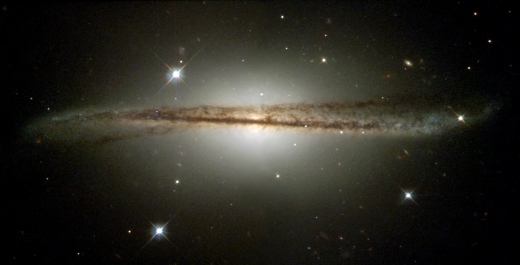
Image: The galaxy ESO 510-G13 is an edge-on warped spiral galaxy. Similar to the Milky Way it has a pronounced warp in its gaseous disc and a less pronounced warp in its disc of stars. Credit: NASA/Space Telescope Science Institute.
Demonstrating a spiral pattern from within the galaxy under study is not easy, says lead author Xiaodian Chen (Chinese Academy of Sciences, Beijing):
“It is notoriously difficult to determine distances from the Sun to parts of the Milky Way’s outer gas disc without having a clear idea of what that disc actually looks like. However, we recently published a new catalogue of well-behaved variable stars known as classical Cepheids, for which very accurate distances can be determined with an error of only three to five per cent.”
Using Cepheid variables found in data from the Wide-field Infrared Survey Explorer (WISE) mission as well as a variety of optical surveys, the researchers set about producing a three-dimensional picture of the galaxy out to its farthest regions. Cepheid variables are helpful here because they vary in brightness, and their luminosity and pulsation period are directly linked. Observing a Cepheid variable’s pulsation period allows one to know its true luminosity. The distance to the star can then be calculated by comparing known luminosity to the brightness astronomers observe (hence the nickname ‘standard candles’ to describe such stars).
What the scientists found was that the 1339 Cepheids tracked the neutral hydrogen disk of the Milky Way, with an S-like spiral pattern apparent in each as we move toward the galaxy’s outer regions. From the paper:
…we establish a robust Galactic Disk model based on 1,339 classical Cepheids. We provide strong evidence that the warp’s line of nodes is not oriented in the Galactic Centre–Sun direction. Instead, it subtends a mean angle of 17.5° ± 1° (formal) ± 3° (systematic) and exhibits a leading spiral pattern. Our Galaxy thus follows Briggs’ rule for spiral galaxies, which suggests that the origin of the warp is associated with torques forced by the massive inner disk . The stellar disk traced by Cepheids follows the gas disk in terms of their amplitudes; the stellar disk extends to at least 20 kpc… This morphology provides a crucial, updated map for studies of the kinematics and archaeology of the Galactic Disk.
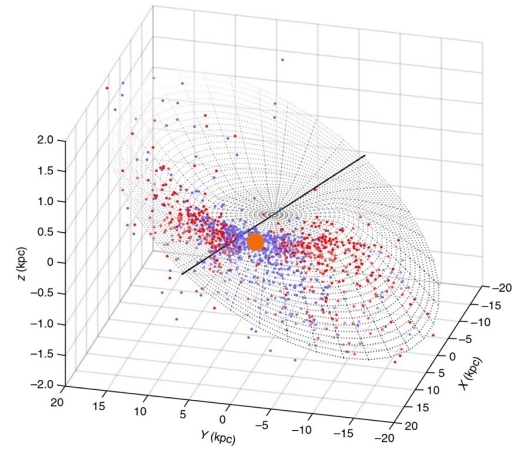
Image: The units ‘kpc’ (kiloparsecs) along the image’s three axes are used by astronomers to indicate distances on galaxy-wide scales. One kiloparsec is equivalent to about 3,262 light years. Credit: Chen et al.
The paper is Chen et al., “An intuitive 3D map of the Galactic warp’s precession traced by classical Cepheids,” Nature Astronomy 04 February 2019 (abstract). Thanks to Alex Tolley for useful information on this work.






February 5, 2019
Cassini Data on Saturn’s Rings, Clouds
Larry Klaes’ article on the film Silent Running, with its images of Saturn originally intended for 2001: A Space Odyssey, makes today’s story the obvious segue, and thus gives me the chance to catch up with some work I‘ve been wanting to write about. For scientists using Cassini data have been able to zero in on the age of Saturn’s rings, an always lively area of controversy, with evidence that the rings formed between 10 million and 100 million years ago. The new analysis is discussed in the journal Science.
How to make such a call? Everything depends on getting a firmer fix on the mass of the rings, which in turn would tell us something about how bright individual ring particles must be. The brightness of the rings should have been affected by soot-like darkening inevitable over time. Fortunately, we had Cassini at Saturn to perform its so-called Grand Finale orbits, 22 dives between the planet and the rings. The gravitational effect of the rings went from being noise in data about the planet’s interior to a measurable quantity about both rings and host world.
“Only by getting so close to Saturn in Cassini’s final orbits were we able to gather the measurements to make the new discoveries,” said Cassini radio science team member and lead author Luciano Iess, of Sapienza University of Rome. “And with this work, Cassini fulfills a fundamental goal of its mission: not only to determine the mass of the rings, but to use the information to refine models and determine the age of the rings.”
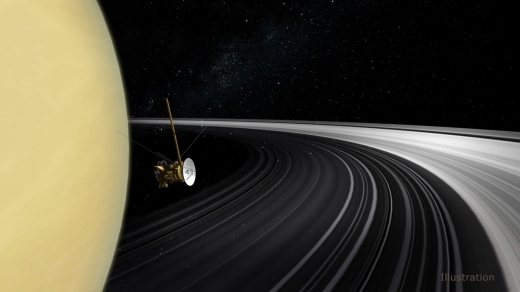
Image: An artist’s concept of the Cassini orbiter crossing Saturn’s ring plane. New measurements of the rings’ mass give scientists the best answer yet to the question of their age. Credit: NASA/JPL-Caltech
Think of Cassini in these orbits as a gravity probe, relaying data on its velocity and acceleration during its passage through Saturn’s gravity field. With acceleration pegged down to a fraction of a millimeter per second, the mass of the planet and its rings could be calculated. Even as we learn that the rings could be as young as 10 million years old, we also find that Saturn’s core has a mass in the range of 15 to 18 times that of Earth. Moreover, vibrations from within Saturn, still unexplained, warp the rings to create a pattern something like the spiral arms of a galaxy.
Iess’ work is actually part of a two-planet project using radio signals from both Cassini and Juno at Jupiter to probe gravitational variations inside the giant planets. The scientist was behind the creation of a radio instrument for Cassini that worked in the Ka band, where signals are largely unhampered by interference from interplanetary plasma. The intent was, among other things, to test general relativity during Cassini’s journey to Saturn. For most of the Cassini mission at Saturn, measuring tiny Doppler shifts in radio signals to study Saturn’s interior was problematic because of the rings, which is why the Grand Finale orbits have been such a game-changer.
Jupiter and Saturn make an interesting pairing for comparison and contrast. I’m looking at a chapter co-authored by Luciano Iess in a volume called Saturn in the 21st Century, written before the recent work. The overview is helpful:
While Jupiter is often thought of as the benchmark giant planet for this class of astrophysical object, now known to be abundant in the universe, Saturn provides an interesting point of comparison and departure for understanding giant planet structure and evolution… For instance, Jupiter models are highly sensitive to the equation of state (EOS, the relation between important quantities such as temperature, pressure and density) of hydrogen, the most abundant element in the universe, and thus can help to probe the phase space region around a few megabars and ten thousand Kelvin, for which accurate lab experimental data are not available yet. Saturn, on the other hand, with 30% of Jupiter’s mass, probes less of hydrogen’s phase space but has its own host of complex issues. With its peculiar magnetic field and high intrinsic luminosity, Saturn provides challenges to our understanding of the first-order properties that define a gas giant planet. For both planets, an understanding of their bulk composition can come from interior modeling, which is an important constraint on formation scenarios.
Radio fluctuations have been the key for mapping the gravity field at both Saturn and Jupiter, helping scientists learn about the deep interior. Comparing data for the two (the Jupiter data were released last year), the researchers found that while Jupiter’s core has an indeterminate boundary, Saturn’s core has a higher concentration of heavy elements, tentatively suggesting a better demarcated boundary. A key question: Does this have implications for the formation history of the two worlds?
Here I’ll quote Paul Voosen’s article in the January 17 Science:
Scientists once believed the gas giants formed much like Earth, building up a rocky core before vacuuming gas from the protoplanetary disc. Such a stately process would have likely led to distinct layers, including a discrete core enriched in heavier elements. But Juno’s measurements, interpreted through models, suggested Jupiter’s core has only a fuzzy boundary, its heavy elements tapering off for up to half its radius. This suggests that rather than forming a rocky core and then adding gas, Jupiter might have taken shape from vaporized rock and gas right from the start, says Nadine Nettelmann, a planetary scientist at the University of Rostock in Germany.
Interesting! And so are the differences between Saturn and Jupiter. Saturn’s equatorial atmosphere rotates around the planet faster than its inner layers and core. Only deep within the atmosphere do the layers rotate together, a trait Saturn shares with Jupiter. But the Cassini findings show that Saturn’s layers begin rotating in synchrony much deeper into the planet, as much as 9,000 kilometers down, or three times deeper than the same phenomenon at Jupiter.
“The discovery of deeply rotating layers is a surprising revelation about the internal structure of the planet,” said Cassini Project Scientist Linda Spilker of JPL. “The questions are what causes the more rapidly rotating part of the atmosphere to go so deep, and what does that tell us about Saturn’s interior?”
Even with the new work, we know all too little of Saturn’s deep interior, but so-called ‘ring seismology’ — using effects visible on the rings to draw conclusions about the atmosphere — is for the moment the best tool we have, at least until we get another spacecraft on the scene. As for the rings themselves, they’re losing material to Saturn, an indication of their relative transience. The rings may not have been in existence when the dinosaurs died. Will they be there at all in another 10 million years?
Paul Voosen’s article is “Missions expose surprising differences in the interiors of Saturn and Jupiter,” Science 17 January 2019 (full text). For the work on Jupiter, see Iess, et al., “Measurement of Jupiter’s Asymmetric Gravity Field,” Nature 555 (07 March 2018), 220-222 (abstract); and Guillot et al., “A Suppression of Differential Rotation in Jupiter’s Deep Interior,” Nature 555 (07 March 2018), 227-230 (abstract).






January 31, 2019
AI Colonization: The Founder and the Ambassador
As we look toward future space missions using advanced artificial intelligence, when can we expect to have probes with cognitive capabilities similar to humans? Andreas Hein and Stephen Baxter consider the issue in their paper “Artificial Intelligence for Interstellar Travel” (citation below), working out mass estimates for the spacecraft and its subsystems and applying assumptions about the increase in computer power per payload mass. By 2050 we reach onboard data handling systems with a processing power of 15 million DMIPS per kg.
As DMIPS and flops are different performance measures [the computing power of the human brain is estimated at 1020 flops], we use a value for flops per kg from an existing supercomputer (MareNostrum) and extrapolate this value (0.025∗1012 flops/kg) into the future (2050). By 2050, we assume an improvement of computational power by a factor 105 , which yields 0.025∗1017 flops/kg. In order to achieve 1020 flops, a mass of dozens to a hundred tons is needed.
All of this factors into the discussion of what the authors call a ‘generic artificial intelligence probe.’ Including critical systems like solar cells and radiator mass, Hein and Baxter arrive at an AI probe massing on the order of hundreds of tons, which is not far off the value calculated in the 1970s for the Daedalus probe’s payload. Their figures sketch out a probe that will operate close to the target star, maximizing power intake for the artificial intelligence. Radiators are needed to reject the heat generated by the AI payload. The assumption is that AI will be switched off in cruise, there being no power source enroute to support its operations.
The computing payload itself masses 40 tons, with 100 tons for the radiator and 100 tons for solar cells. We can see the overall configuration in the image below, drawn from the paper.
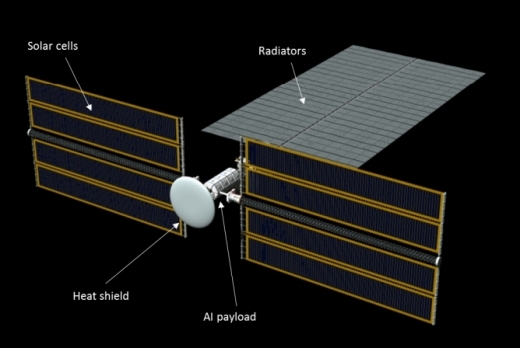
Image: This is Figure 10 from the paper. Caption: AI probe subsystems (Image: Adrian Mann).
Of course, all this points to increasingly powerful AI and smaller payloads over time. The authors comment:
Under the assumption that during the 2050 to 2090 timeframe, computing power per mass is still increasing by a factor of 20.5, it can be seen…that the payload mass decreases to levels that can be transported by an interstellar spacecraft of the size of the Daedalus probe or smaller from 2050 onwards. If the trend continues till 2090, even modest payload sizes of about 1 kg can be imagined. Such a mission might be subject to the ”waiting paradox”, as the development of the payload might be postponed successively, as long as computing power increases and consequently launch cost[s] decrease due to the lower payload mass.
And this is interesting: Let’s balance the capabilities of an advanced AI payload against the mass needed for transporting a human over interstellar distances (the latter being, in the authors’ estimation, about 100 tons). We reach a breakeven point for the AI probe with the cognitive capabilities of a human somewhere between 2050 and 2060. Of course, a human crew will mean more than a single individual on what would doubtless be a mission of colonization. And the capabilities of AI should continue to increase beyond 2060.
It’s intriguing that our first interstellar missions, perhaps in the form of Breakthrough Starshot’s tiny probes, are contemplated for this timeframe, at the same time that the development of AGI — artificial general intelligence — is extrapolated to occur around 2060. Moving well beyond this century, we can envision increasing miniaturization of increasingly capable AI and AGI, reducing the mass of an interstellar probe carrying such an intelligence to Starshot-sized payloads.
From Daedalus to a nano-probe is a long journey. It’s one that Robert Freitas investigated in a paper that took macro-scale Daedalus probes and folded in the idea of self-replication. He called the concept REPRO, a fusion-based design that would use local resources to produce a new REPRO probe every 500 years. But he would go on to contemplate probes no larger than sewing needles, each imbued with one or many AGIs and capable of using nanotechnology to activate assemblers, exploiting the surface resources of the objects found at destination.
As for Hein and Baxter, their taxonomy of AI probes, which we’ve partially examined this week, goes on to offer two more possibilities. The first is the ‘Founder’ probe, one able to alter its environment and establish human colonies. Thus a new form of human interstellar travel emerges. From the paper:
The classic application of a Founder-class probe may be the ‘seedship’ colony strategy. Crowl et al. [36] gave a recent sketch of possibilities for ‘embryo space colonisation’ (ESC). The purpose is to overcome the bottleneck costs of distance, mass, and energy associated with crewed interstellar voyages. Crowl et al. [36] suggested near-term strategies using frozen embryos, and more advanced options using artificial storage of genetic data and matterprinting of colonists’ bodies, and even ‘pantropy’, the pre-conception adaptation of the human form to local conditions. Hein [70] previously explored the possibility of using AI probes for downloading data from probes into assemblers that could recreate the colonists. Although appearing speculative, Boles et al. [18] have recently demonstrated the production of genetic code from data.

Founder probes demand capable AI indeed, for their job can include terraforming at destination (with all the ethical questions that raises) and the construction of human-ready habitats. You may recall, as the authors do, Arthur C. Clarke’s The Songs of Distant Earth (1986), wherein the Earth-like planet Thalassa is the colony site, and the first generation of colonists are raised by machines. Vernor Vinge imagines in a 1972 story called ‘Long Shot’ a mission carrying 10,000 human embryos, guided by a patient AI named Ilse. A key question for such concepts: Can natural parenting really be supplanted by AI, no matter how sophisticated?
Image: The cover of the June, 1958 issue of IF, featuring “The Songs of Distant Earth.” Science fiction has been exploring the issues raised by AGI for decades.
Taken to its speculative limit, the Founder probe is capable of digital to DNA conversion, which allows stem cells carried aboard the mission to be reprogrammed with DNA printed out from data aboard the probe or supplied from Earth. A new human colony is thus produced.
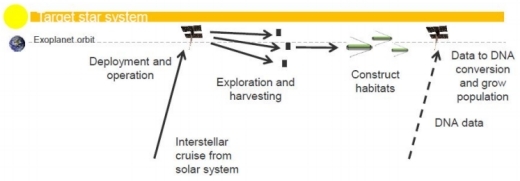
Image: This is Figure 9 from the paper. Caption: On-site production of genetic material via a data to DNA converter.
Hein and Baxter also explore what they call an ‘Ambassador’ probe. Here we’re in territory that dates back to Ronald Bracewell, who thought that a sufficiently advanced civilization could send out probes that would remain in a target stellar system until activated by its detection of technologies on a nearby planet. A number of advantages emerge when contrasted with the idea of long-range communications between stars:
A local probe would allow rapid dialogue, compared to an exchange of EM signals which might last millennia. The probe might even be able to contact cultures lacking advanced technology, through recognizing surface structures for example [11]. And if technological cultures are short-lived, a probe, if robust enough, can simply wait at a target star for a culture ready for contact to emerge – like the Monoliths of Clarke’s 2001 [32]. In Bracewell’s model, the probe would need to be capable of distinguishing between local signal types, interpreting incoming data, and of achieving dialogue in local languages in printed form – perhaps through the use of an animated dictionary mediated by television exchanges. In terms of message content, perhaps it would discuss advances in science and mathematics with us, or ‘write poetry or discuss philosophy’…
Are we in ‘Prime Directive’ territory here? Obviously we do not want to harm the local culture; there are planetary protection protocols to consider, and issues we’ve looked at before in terms of METI — Messaging Extraterrestrial Intelligence. The need for complex policy discussion before such probes could ever be launched is obvious. Clarke’s ‘Starglider’ probe (from The Fountains of Paradise) comes to mind, a visitor from another system that uses language skills acquired by radio leakage to begin exchanging information with humans.
Having run through their taxonomy, Hein and Baxter’s concept for a generic artificial intelligence probe, discussed earlier, assumes that future human-level AGI would consume as much energy for operations as the equivalent energy for simulating a human brain. Heat rejection turns out to be a major issue, as it is for supercomputers today, requiring the large radiators of the generic design. Protection from galactic cosmic rays during cruise, radiation-hardened electronics and self-healing technologies in hardware and software are a given for interstellar missions.
Frank Tipler, among others, has looked into the possibility of mind-uploading, which could theoretically take human intelligence along for the ride to the stars and, given the lack of biological crew, propel the colonization of the galaxy. Ray Kurzweil has gone even further,by suggesting that nano-probes of the Freitas variety might traverse wormholes for journeys across the universe. Such ideas are mind-bending (plenty of science fiction plots here), but it’s clear that given the length of the journeys we contemplate, finding non-biological agents to perform such missions will continue to occupy researchers at the boundaries of computation.
The paper is Hein & Baxter, “Artificial Intelligence for Interstellar Travel,” submitted to JBIS (preprint).






January 29, 2019
Future AI: The Explorer and the Philosopher
Robert Bradbury had interesting thoughts about how humans would one day travel to the stars, although whether we could at this point call them human remains a moot point. Bradbury, who died in 2011 at the age of 54, reacted at one point to an article I wrote about Ben Finney and Eric Jones’ book Interstellar Migration and the Human Experience (1985). In a comment to that post, the theorist on SETI and artificial intelligence wrote this:
Statements such as “Finney believes that the early pioneers … will have so thoroughly adapted to the space environment” make sense only once you realize that the only “thoroughly adapted” pioneers will be pure information (i.e. artificial intelligences or mind uploaded humans) because only they can have sufficient redundancy that they will be able to tolerate the hazards that space imposes and exist there with minimal costs in terms of matter and energy.
Note Bradbury’s reference to the hazards of space, and the reasonable supposition — or at least plausible inference — that biological humanity may choose artificial intelligence as the most sensible way to explore the galaxy. Other scenarios are possible, of course, including humans who differentiate according to their off-Earth environments, igniting new speciation that includes unique uses of AI. Is biological life necessarily a passing phase, giving way to machines?
I’ll be having more to say about Robert Bradbury’s contribution to interstellar studies and his work with SETI theorist Milan Ćirković in coming months, though for now I can send you to this elegant, perceptive eulogy by George Dvorsky. Right now I’m thinking about Bradbury because of Andreas Hein and Stephen Baxter, whose paper “Artificial Intelligence for Interstellar Travel” occupied us yesterday. The paper references Bradbury’s concept of the ”Matrioshka Brain,” a large number of spacecraft orbiting a star producing the power for the embedded AI.
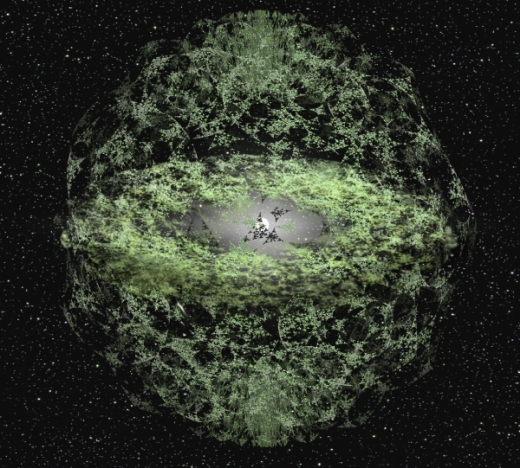
Image: Artist’s concept of a Matrioshka Brain. Credit: Steve Bowers / Orion’s Arm.
Essentially, a Matrioshka brain (think dolls within dolls like the eponymous Russian original) resembles a Dyson sphere on the surface, but now imagine multiple Dyson spheres, nested within each other, drawing off stellar energies and cycling levels of waste heat into computational activities. Such prodigious computing environments have found their way into science fiction — Charles Stross explores the possibilities, for example, in his Accelerando (1985).
A Matrioshka brain civilization might be one that’s on the move, too, given that Bradbury and Milan Ćirković have postulated migration beyond the galactic rim to obtain the optimum heat gradient for power production — interstellar temperatures decrease with increased distance from galactic center, and in the nested surfaces of a Matrioshka brain, the heat gradient is everything. All of which gives us food for thought as we consider the kind of objects that could flag an extraterrestrial civilization and enable its deep space probes.
But let’s return to the taxonomy that Hein and Baxter develop for AI and its uses in probes. The authors call extensions of the automated probes we are familiar with today ‘Explorer probes.’ Even at our current level of technological maturity, we can build probes that make key adjustments without intervention from Earth. Thus the occasional need to go into ‘safe’ mode due to onboard issues, or the ability of rovers on planetary surfaces to adjust to hazards. Even so, many onboard situations can only be resolved with time-consuming contact with Earth.
Obviously, our early probes to nearby stars will need a greater level of autonomy. From the paper:

On arrival at Alpha Centauri, coming in from out of the plane of a double-star system, a complex orbital insertion sequence would be needed, followed by the deployment of subprobes and a coordination of communication with Earth [12]. It can be anticipated that the target bodies will have been well characterised by remote inspection before the launch of the mission, and so objectives will be specific and detailed. Still, some local decision-making will be needed in terms of handling unanticipated conditions, equipment failures, and indeed in prioritising the requirements (such as communications) of a multiple-subprobe exploration.
Image: Co-author Andreas Hein, executive director of the Initiative for Interstellar Studies. Credit: i4IS.
Feature recognition through ‘deep learning’ and genetic algorithms are useful here, and we can envision advanced probes in the Explorer category that can use on-board manufacturing to replace components or create new mechanisms in response to mission demands. The Explorer probe arrives at the destination system and uses its pre-existing hardware and software, or modifications to both demanded by the encounter situation. As you can see, the Explorer category is defined by a specific mission and a highly-specified set of goals.
The ‘Philosopher’ probes we looked at yesterday go well beyond these parameters with the inclusion of highly advanced AI that can actually produce infrastructure that might be used in subsequent missions. Stephen Baxter’s story ‘Star Call’ involves a probe that is sent to Alpha Centauri with the capability of constructing a beamed power station from local resources.
The benefit is huge: Whereas the Sannah III probe (wonderfully named after a spaceship in a 1911 adventure novel by Friedrich Mader) must use an onboard fusion engine to decelerate upon arrival, all future missions can forego this extra drain on their payload size and carry much larger cargoes. From now on incoming starships would decelerate along the beam. Getting that first mission there is the key to creating an infrastructure.
The Philosopher probe not only manufactures but designs what it needs, leading to a disturbing question: Can an artificial intelligence of sufficient power, capable of self-improvement, alter itself to the point of endangering either the mission or, in the long run, its own creators? The issue becomes more pointed when we take the Philosopher probe into the realm of self-replication. The complexity rises again:

…for any practically useful application, physical self-replicating machines would need to possess considerable computing power and highly sophisticated manufacturing capabilities, such as described in Freitas [52, 55, 54], involving a whole self-replication infrastructure. Hence, the remaining engineering challenges are still considerable. Possible solutions to some of the challenges may include partial self-replication, where complete self-replication is achieved gradually when the infrastructure is built up [117], the development of generic mining and manufacturing processes, applicable to replicating a wide range of components, and automation of individual steps in the replication process as well as supply chain coordination.
Image: Stephen Baxter, science fiction writer and co-author of “Artificial Intelligence for Interstellar Travel.” Credit: Stephen Baxter.
The range of mission scenarios is considerable. The Philosopher probe creates its exploration strategy upon arrival depending on what it has learned approaching the destination. Multiple sub-probes could be created from local resources, without the need for transporting them from Earth. In some scenarios, such a probe engineers a destination planet for human habitability.
But given the fast pace of AI growth on the home world, isn’t it possible that upgraded AI could be transmitted to the probe? From the paper:
This would be interesting, in case the evolution of AI in the solar system is advancing quickly and updating the on-board AI would lead to performance improvements. Updating on-board software on spacecraft is already a reality today [45, 111]. Going even a step further, one can imagine a traveling AI which is sent to the star system, makes its observations, interacts with the environment, and is then sent back to our solar system or even to another Philosopher probe in a different star system. An AI agent could thereby travel between stars at light speed and gradually adapt to the exploration of different exosolar environments.
We still have two other categories of probes to consider, the ‘Founder’ and the ‘Ambassador,’ both of which will occupy my next post. Here, too, we’ll encounter many tropes familiar to science fiction readers, ideas that resonate with those exploring the interplay between space technologies and the non-biological intelligences that may guide them to another star. It’s an interesting question whether artificial general intelligence — AGI — is demanded by the various categories. Is a human- or better level of artificial intelligence likely to emerge from all this?
The paper is Hein & Baxter, “Artificial Intelligence for Interstellar Travel,” submitted to JBIS (preprint).






Paul Gilster's Blog
- Paul Gilster's profile
- 7 followers



